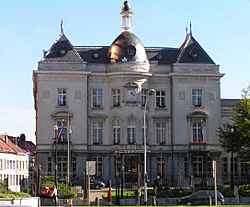Saint-Josse-ten-Noode facts for kids
Quick facts for kids
Saint-Josse-ten-Noode
Sint-Joost-ten-Node (Dutch)
|
|||
|---|---|---|---|

Saint-Josse-ten-Noode's Municipal Hall
|
|||
|
|||
| Country | Belgium | ||
| Community | Flemish Community French Community |
||
| Region | Brussels | ||
| Arrondissement | Brussels-Capital | ||
| Area | |||
| • Total | 1.14 km2 (0.44 sq mi) | ||
| Population
(2018-01-01)Lua error in Module:Wd at line 1575: attempt to index field 'wikibase' (a nil value).
|
|||
| • Total | Lua error in Module:Wd at line 1,575: attempt to index field 'wikibase' (a nil value). | ||
| Postal codes |
1210
|
||
| Area codes | 02 | ||
| Website | sjtn.brussels/en sjtn.brussels/fr sjtn.brussels/nl |
||
Saint-Josse-ten-Noode (in French) or Sint-Joost-ten-Node (in Dutch) is one of the 19 areas that make up the Brussels-Capital Region in Belgium. People often just call it Saint-Josse or Sint-Joost. It's located in the north-eastern part of the Brussels area, next to the City of Brussels and Schaerbeek.
As of 2022, about 26,965 people lived here. The total area is very small, only 1.16 square kilometers. This means it's super crowded, with about 23,234 people living in each square kilometer! Saint-Josse is actually the smallest and most densely populated area in all of Belgium. Like all parts of Brussels, both French and Dutch are official languages here.
Contents
A Look at Saint-Josse's Past
Saint-Josse-ten-Noode is named after a saint called Judoc. Long ago, it was just a small farming village right outside Brussels. Before the big walls around Brussels were taken down, rich noblemen built their country homes here. One famous home was the Castle of the Dukes of Brabant, built in 1456 by Philip the Good. The land around this castle had many grapevines, which is why you can see a bunch of grapes on the area's coat of arms today!
After the city walls were removed, Saint-Josse was one of the first places outside Brussels to grow into a town. Wealthy people built houses on the higher parts and along the new main roads. Factories and homes for workers were built closer to the Senne river. In 1855, a big part of Saint-Josse was taken over by the City of Brussels. This land was used to create new squares and avenues, which are now part of the European Quarter.
Did you know that Saint-Josse has some of the oldest buildings in all of Brussels? An official study found that its buildings are, on average, older than those in the other 18 Brussels areas.
Who Lives in Saint-Josse?
The population of Saint-Josse is very diverse! In 1995, most people living here were from other countries. But by 2007, more people had become Belgian citizens. This change meant that more local leaders with backgrounds from other countries were elected. For example, in 1988, there were no council members from other countries. But by 2007, 20 out of 27 council members had foreign backgrounds! This shows how the community has grown and changed over time.
| Citizenship | 1979 | 1995 | 2007 | |||
|---|---|---|---|---|---|---|
| Belgium | 12,222 | 54.5% | 9,231 | 42.1% | 14,656 | 61.6% |
| Turkey | 2,304 | 10.3% | 3,904 | 18.1% | 1,527 | 6.4% |
| Morocco | 2,664 | 11.9% | 3,761 | 17.5% | 1,482 | 6.2% |
| France | ― | ― | ― | ― | 674 | 2.8% |
| Italy | 1,661 | 7.4% | 785 | 3.6% | 458 | 1.9% |
| Congo (DRC) | 198 | 0.9% | ― | ― | 453 | 1.9% |
| Poland | ― | ― | ― | ― | 432 | 1.8% |
| Romania | ― | ― | ― | ― | 387 | 1.6% |
| Spain | 840 | 3.7% | 443 | 2.1% | 317 | 1.3% |
| Bulgaria | ― | ― | ― | ― | 251 | 1.1% |
| Total pop. | 22,409 | 21,522 | 23,785 | |||
Arts and Culture in Saint-Josse
Saint-Josse has some cool places to explore art and music:
- The Charlier Museum is a great spot to see Belgian art from the late 1800s.
- The Jazz Station is a museum and archive all about jazz music. It also hosts live jazz concerts, so you can hear the music come alive!
Images for kids
See also
 In Spanish: Saint-Josse-ten-Noode para niños
In Spanish: Saint-Josse-ten-Noode para niños





